
Original Link: https://www.anandtech.com/show/2085
Digital Photography from 20,000 Feet
by Wesley Fink on September 25, 2006 12:05 AM EST- Posted in
- Digital Camera
It is remarkable how fast photography has shifted from film to digital imaging. If you doubt the shift is all but complete, check the impact on Kodak. Shutdown of US film operations has been accelerated several times, many thousands of employees have been cut, and Kodak stock has taken a beating as the company struggled to find secure footing in a new digital imaging world. All of this was happening while Kodak invested millions in developing digital imaging solutions in a market that was shifting like quicksand.
Digital, of course, is the domain of the computer, and the transition of artistic photographers to digital has been anything but smooth. The artistic types distrust turning their vision into cheap Adobe Photoshop tricks, and the tech-savvy are so enamored of technology and editing that they often don't have a clue about what makes a good photograph and what lens to use in a given situation. As AnandTech prepares to re-launch Digital Photography reviews, it is important that our readers understand at least the basics of digital photography. That is the purpose of this guide.
There are plenty of Digital Camera Review sites out on the web, so you may ask why AnandTech is re-launching a Digital Photography section? If you are a photographer or serious photo hobbyist you have many excellent review sites already available. They do a great job of providing the kind of information the serious photo hobbyist is looking for. However, our readers who visit those sites are often overwhelmed with the sheer amount of information and the background required to make that information accessible. For a computer enthusiast who wants to learn about digital cameras to make a buying decision, many current sites are a difficult place to find answers. Some sites make the assumption that the reader knows a lot more about photography than our average reader, which often leads to much of the review being gibberish to a non-photographer. Other sites dwell on tests of things like "start-up times" that were important in early digital, but have become all but meaningless in today's digital SLR market unless you are a professional sports photographer. Still other sites, which are very well-grounded in the traditional photography side show an obvious lack of knowledge about computers and computer tools that make digital photography so flexible today.
Some of our readers may not like AT delving into Digital Camera Reviews, and to them we say you just can't ignore digital photography any more. Today's digital imaging is nothing more than an optic stuck on a computer, and unfortunately there is very little left of the mechanical gems that once ruled the world of photography. It is our sincere belief that we can do digital camera reviews with a unique perspective for our readers and computer enthusiasts everywhere, but please help us as we try to reinvent this wheel.
There are some things about photography that have not changed in the move to digital, however. In the end taking a digital photo is still basically dependent on the same set of "rules" as taking a film image, as the only real difference in digital and film is what happens after the image is captured. This is particularly obvious in looking at Digital SLR cameras, which are currently the fastest growing segment of the Digital Photography market. You will find all the traditional photography names here - Nikon, Canon, Pentax, Olympus, Minolta - and this is where the "real" photographers work. Names like Casio, HP, Sony, Fuji, Samsung and Kodak don't exist in SLR space - except as the odd offering based on the lenses of one of the "real" Photography companies.
The reasons for this are really quite clear. Digital and computer imaging have concentrated on the sensor and ever increasing megapixel counts, while the people who take photographs for a living have continued to concentrate on the quality of the lenses they work with and the images that they sell. In both film and digital, all other things being equal, the best quality lens wins. Of course the best quality lenses and the widest variety of lenses come from the traditional photo companies like Canon, Nikon, Minolta, Pentax and Olympus. These companies have taken years to develop their extensive line of lenses, and these lenses are the ones in the hands of photographers. Today, it takes a lot of money and effort to develop a new lens line. As a result you have amalgams like Samsung using the Pentax lens line on their SLR, a Fuji Pro camera using Nikon lenses, and past Kodak Pro Digitals designed for both Canon and Nikon lens mounts - two models for each Pro camera.
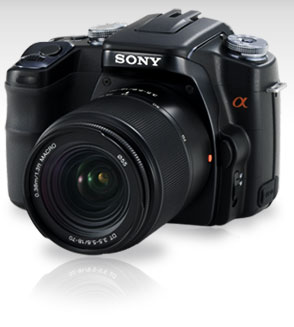
Recently Sony introduced their first SLR, and one of our first digital camera reviews at AT will be the new Sony Alpha or A100. So did Sony break the rules? Sony is one of the world's largest manufacturers of digital sensors - the chip that captures an image in digital format. In fact you will see Sony sensors in almost every brand of "serious" camera except Canon and Olympus. Sony makes sensors for Nikon, Pentax and Minolta. Canon is another huge sensor manufacturer and makes their own sensors for their cameras, while Kodak and Panasonic both make four-thirds sensors used by Olympus in their various models.
Sony has some very feature-rich and capable fixed lens cameras in their lineup, and their own form factor for memory, but Sony has coveted a big piece of the "serious" photography or SLR market. Sony apparently did not want to brand themselves a second tier player in the SLR market by offering an SLR for other brand lenses. Instead they entered into a joint development agreement with Konica-Minolta last year. Then, early this year, Sony bought the Konica-Minolta camera business and announced they would continue development of the 20-year old Minolta auto-focus lens system to work with their own new Digital SLR cameras.
The Sony Alpha or A100 is the first camera that marries Sony technology with the Minolta system. It is a new Digital SLR brand with a new Sony 10.2 megapixel sensor and an existing lens base of some 20 million Minolta Auto-Focus lenses. By purchasing the Konica Minolta camera business and assuming warranty responsibilities, Sony instantly became a major player with a full lens line. When you consider that only Sony and Canon make their own sensors for their digital SLR cameras you can clearly see what Sony can leverage in the DSLR market, and why they were willing to buy an existing lens line. Sony didn't break the rules, they just bought instant credibility in a market that is difficult to crack.
If you want to learn about digital photography you should find this guide a good place to start. If you are in the market for a new Digital SLR then this is a good place to gain the background to intelligently compare these cameras. The Digital SLR market is hot and we will be covering the six new 10 megapixel cameras that sell for less than $1000 in detail in the coming months: the Sony A100, Nikon D80, Canon Rebel XTi, Olympus E-400 (Europe/Asia only), Pentax K10D, and Samsung GX-10.
Digital Directions
When consumer Digital Photography first launched over a decade ago, the only real choice for the average consumer was a point-and-shoot camera, which was completely unlike the SLR cameras that ruled the Amateur and Hobbyist film market. The image quality of the initial offerings was also poor at best, with the first models offering 0.3 megapixel sensors (640x480 images). However, the market was developing fast and megapixel ratings - the number of dots that were used to create an image - were moving higher by leaps and bounds. All of the cameras from that era seemed to have way too many compromises - slow start-up, long times to process and save an image, mediocre optics, extremely limited dynamic range, and color flaws. There were a few great ones along the way, but the market had to develop for a while before Digital cameras for photo hobbyists could even approach being as good as film-based cameras.
That goal was still a ways off, as the digital SLR cameras the Pros used had massive power requirements, battery packs that looked like they belonged in hybrid cars, and price tags of $20,000 or more. Most agreed the goal was the familiar and flexible SLR (Single Lens Reflex) format that could take advantage of the huge inventory of lenses that had developed over 40 years. It seemed every Pro and most 35mm hobbyists had a large number of lenses they would love to use on digital camera bodies.
Progress in technology development was rapid, prices dropped quickly, and most agree the photography enthusiast finally got a real camera option at a doable price with the introduction of the Canon Digital Rebel in October 2003 - just 3 short years ago. The Digital Rebel finally broke the magic $1000 price barrier for a 6 megapixel SLR and an 18-55mm lens. That kind of pricing was unheard of just 3 years ago and the Digital Rebel sold in huge volume.
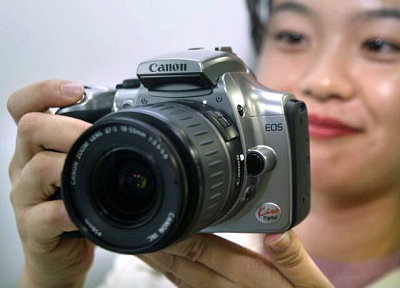
The Press was astounded by the value of the Rebel, as shown in this quote in October 2003 from Steve's Digicams:
"The 'magic' $1000 price mark for digital SLRs has been broken like the sound barrier and Canon is positioning the EOS Digital Rebel as 'the digital SLR for everyone.' These cameras will be an instant hit with those wanting a digital camera that works the same as their 35mm SLR, and dealers will no doubt sell them as fast as Canon can make them. And Canon is planning on making a lot of them. They announced at the London press event that production was set at an amazing 70,000 units a month. The Digital Rebel may not be black, but don't let the silver-colored body fool you, this isn't some cheap knock-off. It's loaded with state of the art imaging technology and is sure to please both novice and seasoned photographers alike."
The 6 megapixel Canon Digital Rebel can still be bought today, although the bigger seller is the updated 8 megapixel Rebel XT. The important thing from a photography enthusiast point-of-view is that the Rebel was an inexpensively built camera with digital features previously unheard of at the selling price. Canon designed the Digital Rebel for mass sales. It was a bit of an upscale move from the 35mm Rebel series that had been advertised on TV by John McEnroe, but they were designed to be mass market. The Digital SLR had finally arrived, and would quickly grow to dominate the digital photography market.
Many readers do not realize how very much the Digital Photography market has changed since the introduction of the Digital Rebel. The $1000 price now seems high since today you can buy a Pentax Digital SLR, the *ist DL, with an 18-55mm lens for less than $500 (the body alone is $379). The price of entry for the 6 megapixel DSLR has dropped by almost 50%. This has led to Digital SLRs becoming the fastest growing segment of the Digital Camera market. Camera makers are still making point-and-shoots, and the market leader in Digital point-and-shoot cameras is now Kodak (does this sound familiar?). Big and serious players in the market have quickly moved to introduce cheaper and cheaper DSLR cameras at the bottom, and more and more resolution and features in the now "middle" $1000 price range.
This does not mean that digital point-and-shoot cameras are now useless. There will always be a market for very small, pocketable point-and-shoot cameras. That was also true in the 35mm film market. It does mean, however, that the SLR-like high-speed fixed-lens digitals in the $400 to $800 price range are having a tough time these days. The point-and-shoot offerings of tiny "stealth" cameras and mainstream point-and-shoot will continue to be targeted at families to shoot vacation pictures of their kids - the typical Kodak market. Sooner than later you will likely even see reusable digital point-and-shoots similar to today's disposable film cameras. The companies make money on paper and ink, so this market segment is a natural for Kodak and HP as technology costs continue to decline.
Why the Digital SLR?
SLR cameras have been around for more than 50 years, but it is remarkable how many of those shopping for a digital camera have no idea why the market is moving to the SLR or Single Lens Reflex. Up until the late 1940's the world of hobbyist photography was ruled by 35mm point-and-shoot and rangefinder cameras. These cameras were not really that different from the point-and-shoot cameras that we have today in digital photography, except that they did not have the benefit of all the electronics that are part of today's digital cameras. The cheap point-and-shoots used a fixed focus lens, which meant the lens always shot a certain range (depth-of-field) in focus - no matter whether the subject was in that range or not. The better of these cameras used rangefinders, which were two images from two optics superimposed in the viewfinder. When these two images merged in the viewfinder your subject was in focus. As you can imagine the optics to allow focusing were pretty complicated and expensive to build. However, with a fixed lens that never changed it was possible to design and manufacture some very reliable and affordable rangefinder cameras.
The top end of the amateur photography market, which had embraced 35mm as the "miniature" film standard, then introduced a brilliant idea. Why not manufacture cameras that could use multiple lenses. This would allow the photo hobbyist to use the lens that was best suited for what they were photographing - like a wide-angle lens for interiors, or a telephoto for sporting events and far away subjects. Companies like Leica and Contax pioneered these interchangeable lens rangefinder cameras in the 1930s. After World War II, German camera companies resumed camera manufacturing. Japan, which had manufactured quality optics for a more limited market before WWII, also began making quality interchangeable lens rangefinders. Japanese companies like Canon, Aries, and Nikon championed cameras with changeable lenses.
The ability to change lenses was a great idea, but the execution was anything but simple. Viewfinders started having multiple frames engraved for the different focal lengths like 35mm, 50mm, 85mm. The user had to remember that the tiny square was 85mm. Leica and others had accessory viewfinders that mounted on the flash shoe so you could see about what the lens saw. The problem with the rangefinder is that the viewfinder and the lens never see the same thing. This was not a huge issue with a fixed lens, since the viewfinder could be matched reasonably well to the lens. There were even complicated mechanics that adjusted the viewfinder for "parallax error" on rangefinder close-ups. But with interchangeable lenses the situation became very complicated.
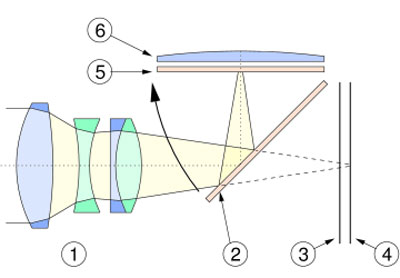
The first popular solution to this problem was the German Exacta, fist produced in 1936. The Exacta had a waist level-finder and a flipping 45-degree mirror. With a flipping mirror, you could look through the lens for composition and focusing - seeing the same view as the lens. You looked at the image from above the camera (5), the image was backwards (as in a mirror image), and the mirror was either manually reset or later reset automatically when winding the film, but the view on the ground glass was the same as any lens (1) mounted on the camera.
In the 1950's the Japanese pioneered further development of the SLR design. A roof pentaprism first appeared on an East German Contax S announced in 1949, but the Japanese camera industry refined and perfected the idea. Asahi developed the Asahiflex in 1952, and in 1954 the Asahiflex IIB. In 1957, Asahi Pentax introduced the fixed pentaprism and the right-hand thumb wind lever. Minolta introduced their first SLR, the SR-2, in 1958. Nikon, Canon and Yashica introduced their first SLRs in 1959 (the F, Canonflex, and Pentamatic, respectively).

The diagram shows how the light passes through the SLR lens assembly (1), is reflected by the mirror (2) and projected on the matte focusing screen (5). Using a condensing lens (6) and internal reflections of the mirrored roof pentaprism (7) the image appears in the eyepiece (8). When an image is taken, the mirror flips up as the arrow indicates, the shutter (3) opens, and the image is projected onto the film or digital sensor (4) The image at the film or sensor is exactly the same as on the focusing screen. [Image from Wikipedia.]
By the early 1960s the basic form of the SLR had evolved to what we know today, as you can see in this photo of the original Nikon F SLR.
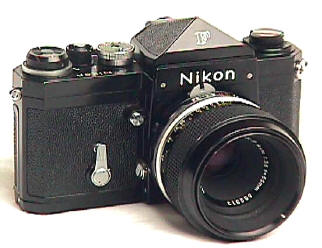
Refinements have continued to expand the usefulness of the SLR design. The Topcon RE Super and Asahi Pentax Spotmatic pioneered through the lens metering in the early 60's. Auto exposure was first seen in the Pentax Spotmatic F in 1971, and it was popularized with the Canon AE-1 Program in 1976. Pentax made a limited attempt at autofocus in 1981 with a 35-70 f2.8 lens for the Pentax ME-F. A few years later, Minolta brought out the first real autofocus camera, the MAXXUM 7000, in 1985. The autofocus auto-everything Maxxum 7000 was wildly popular and made autofocus a virtual requirement on future SLR designs.
The Digital SLR
Several factors delayed the move to SLR technology for digital photography. First, the early sensors were much lower megapixel resolutions, far too low to begin to compete with film photography. Photo hobbyists saw few advantages to moving to a low resolution system since the reason they used an SLR was high image quality. It wasn't until resolutions reached the 2 to 4 megapixel range that there was any interest in a digital SLR.
Second, the early sensors were very small, developed primarily for video usage. Some tried to develop proprietary systems based on a smaller sensor size with more compact lenses, but nothing caught on in the industry. The cost of early sensors was also astronomical, making the early digital SLR cameras only useful for production, high volume photography where the cost could be justified.
Third, with sensor resolution and size in constant development it was much easier to design a point-and-shoot camera around each new sensor generation. Until sensor size stabilized, a digital SLR that used existing lens systems was not practical.
APS (Advanced Photo System)
35mm first appeared on the scene in the 1930s and the film format simply took 35mm motion picture film and spooled it into a light-tight canister. By the 1960s, with point-and-shoot and developments in SLR technology, 35mm had become king of the film formats. Even as film manufacturers tried to introduce other film formats, 35mm continued to grow and prosper. With the very early developments in digital photography, Kodak, Fuji and others saw the handwriting on the wall for film photography. One of the ongoing complaints about 35mm film, however, has been that the 2:3 image format required image loss in almost every standard print size. 8x10 and 5x7 are neither a 2:3 ratio and both required cropping of the 35mm negative.
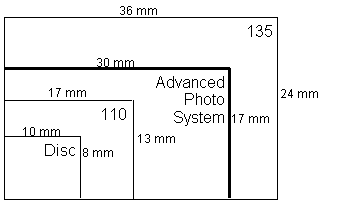
In 1996 a new APS (Advanced Photo System) initiative by Kodak, Fujifilm, Minolta, Nikon, Canon and others was introduced to save film by standardizing on new ratios and adding new "computer-like" data storage capabilities in the taking and processing of images. APS included a new film size - 30.2mm x 16.7mm - that could be printed full-frame (H or HDTV format), or use standard crops of 25.1mm x 16.7mm (C or Classic 2:3 format) or 9.5mm x 30.2mm (P or Panorama). Actually, the image size that was always shot was the 30.2mm x 16.7mm, and the other sizes were just standard crops.
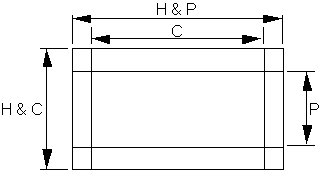
The industry was confident they could sell APS, which in the most common C view was only about 55% of the already small 35mm size. Some manufacturers like Minolta developed new APS lens lines with smaller cameras and lenses, and Canon and Nikon developed APS camera bodies that could mount their regular lenses - and a few custom APS lenses.
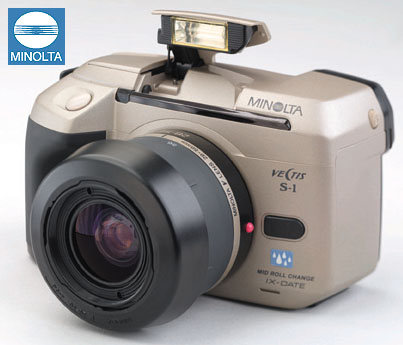
In the end, APS failed in the film market, but it is important in our discussion of Digital Photography because it was also a standard for digital development. At the time of the APS initiatives, it seemed reasonable to aim for development of digital sensors for that same APS format, so lenses for both systems were interchangeable. The industry aimed for the APS C size sensor, which would be about 16.7mm x 25.1mm the same ratio (2:3) as the classic 35mm format. This allowed existing 35mm lenses to be used, with a lens factor of 1.5 to 1.6, and the development of new lenses with a smaller image circle.
What do we mean by Lens Factor? Why does it matter?
The Lens Factor
APS really doesn't matter in the film market, except as a brief and intense flurry of activity that has produced a huge number of APS cameras in every imaginable format. Some of the high-end models are particularly interesting and will become collectibles. APS cameras like the tiny Minolta Vectis S-1 SLR system, the Canon IX, and Nikon Pronea are remarkably well-built and intelligent designs for the APS format.
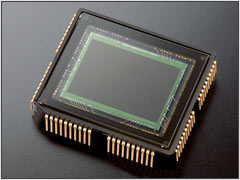
The APS may be discontinued and dying in the film market, but it is alive and well in today's Digital SLR market. Today Sony, Nikon, Canon, Pentax, Minolta, Samsung and every other production SLR on the market (except Olympus) uses a sensor that is approximately APS C size. This matters because the lenses designed for 35mm SLR photography do not behave the same when used to capture images with the smaller APS sensor.
Understanding 35mm and Digital Lenses
If you have no interest in understanding what different lenses do and when to use them, then don't buy a Digital SLR. The main reason SLR exists is to offer a flexible platform for using a wide range of lenses. You could justify the quality aspect and through the lens viewing, but you can find those features on fixed lens cameras. People who buy a digital SLR with one lens they never change and never intend to change are basically wasting their money - they should buy a quality point-and-shoot or fixed lens SLR.
Image Size
To understand how different lenses behave and which lens to use in digital photography we need to go back to 35mm basics. Early 35mm cameras generally shipped with a single focal length "normal" lens. "Normal" is defined as the approximate point of view of your single eye when looking at a scene. That is, if you keep both eyes open when looking through a viewfinder, a camera with a normal lens will look about the same as what the other eye not looking through the lens sees. It is easy to determine the "normal" lens focal length for any image size - it is approximately equal to the diagonal of the image size, which is obviously about the same as the field of view if you consider that as a circle.
| Traditional Film Image and Lens Characteristics | |||
| Film format | Image dimensions | Image diagonal | Normal lens focal length |
| APS C | 1.67 cm x 2.51 cm | 30.15 mm | 28 mm, 35 mm |
| 135 | 2.4 cm x 3.6 cm | 43.27 mm | 50 mm, 45 mm |
| 120/220, 6 x 4.5 (645) | 5.6 cm x 4.2 cm | 70.00 mm | 75 mm |
| 120/220, 6 x 6 | 5.6 cm x 5.6 cm | 79.20 mm | 80 mm |
| 120/220, 6 x 7 | 5.6 cm x 6.8 cm | 88.09 mm | 90 mm |
| 120/220, 6 x 9 | 5.6 cm x 8.2 cm | 99.30 mm | 105 mm |
| large format 4 x 5 sheet film | 10.16 cm x 12.7 cm (4" x 5") | 162.64 mm | 150 mm |
| large format 8 x 10 sheet film | 20.32 cm x 25.4 cm (8" x 10") | 325.27 mm | 355 mm (14") |
This means a normal lens for 35mm would be about 45mm. For those who enjoy history you might be interested to know that the 35mm normal lens got defined as 50mm by Oskar Barnack, the creator of the Leica camera. At the time lens technology could produce sharper lenses if they were slightly longer than normal, so Barnack defined normal as 50mm on the early Leicas. The definition stuck, but most would agree normal on 35mm is anywhere between 40 and 58mm. Lenses with shorter focal lengths than normal are called wide angle, because they see more than the normal lens, and longer focal lengths are called telephoto.
You can see from the chart above that "normal" for APS C size, used in most digital SLRs, is about 28mm - and not the 45mm to 50mm typical of 35mm. The digital normal is a little more complicated than the simple math of film normal, because it got defined in the 1950s by TV tube size (normal is about 2/3 TV tube size). However, the real image size for APS C in digital ranges from about 22.7mm x 15.1mm to 23.7 x 15.8mm (sometimes called DX). This means that 28mm is close enough for this discussion.
For those of you who have looked at Digital Camera specs and wonder what a 1/1.8" sensor means in point-and-shoot digital specifications, it means an image size of 7.18mm x 5.32mm - MUCH smaller than the 22.7mm x 15.1mm of APS C. You can see the translations in the chart below of digital.
| Digital Image and Lens Characteristics | ||||
| Sensor type | TV-tube diameter | Image dimensions | Image diagonal | Normal lens focal length |
| 1/3.6" | 7.1 mm | 4.00 x 3.00 mm | 5.00 mm | 5 mm |
| 1/3.2" | 7.9 mm | 4.54 x 3.42 mm | 5.68 mm | 5.7 mm |
| 1/3" | 8.5 mm | 4.80 x 3.60 mm | 6.00 mm | 6 mm |
| 1/2.7" | 9.4 mm | 5.37 x 4.04 mm | 6.72 mm | 6.7 mm |
| 1/2.5" | 10.2 mm | 5.76 x 4.29 mm | 7.2 mm | 7 mm |
| 1/2" | 12.7 mm | 6.40 x 4.80 mm | 8.00 mm | 8 mm |
| 1/1.8" | 14.1 mm | 7.18 x 5.32 mm | 8.93 mm | 9 mm |
| 1/1.7" | 14.9 mm | 7.60 x 5.70 mm | 9.50 mm | 9.5 mm |
| 1/1.6" | 15.9 mm | 10.5 mm | ||
| 2/3" | 16.9 mm | 8.80 x 6.60 mm | 11.00 mm | 11 mm |
| 1" | 25.4 mm | 12.80 x 9.60 mm | 16.00 mm | 16 mm |
| 4/3" | 33.9 mm | 18.00 x 13.50 mm | 22.50 mm | 23 mm |
| (APS-C) 1/8" | 45.7 mm | 22.70 x 15.10 mm | 27.3 mm | 27 mm |
| DX | n/a | 23.7 x 15.8 | 28.40 mm | 28 mm |
| FF (35 mm film) | n/a | 36 x 24 mm | 43.30 mm | 50 mm |
Since the imaging companies are convinced that consumers understand 35mm lens ranges you will find most point-and-shoot cameras define their zoom or fixed lenses as equivalent 35mm specifications. When you see a Kodak P880, for example, defined as a 24-140mm zoom lens you might also notice it uses a 1/1.8" sensor. Since that sensor is about 9mm at normal, the true focal length of the lens is somewhere around 4-28mm. By calling it 24-140mm the manufacturer hopes the potential buyer understands the zoom range in common terms.
Lenses on Digital SLR Cameras
While digital point-and-shoot makers normally quote their lenses in familiar 35mm terms, no such convention exists in the digital SLR market. Here, everything is the opposite, as all specs are defined in 35mm terms even though the digital SLRs themselves use a smaller APS C size sensor. This is even carried so far as using 35mm equivalents to define lenses designed for the Digital SLR - even though the "digital-design" lenses can't even cover the frame on a full-size 35mm camera. Thus lenses like the common 18-55mm Canon and Pentax kit zooms and the 18-70mm Nikon and Sony (Minolta) kit zooms really describe those lenses as if they were 35mm.
To know what a lens can do on a digital SLR you have to know the lens factor. Nikon, Pentax, Sony, Minolta, Samsung (Sony sensor) and most others use a sensor about 23.6 x 15.8mm with a lens factor of 1.5. This means that if you multiply the stated lens focal length by 1.5 you will get a focal length of how that lens behaves on your Digital SLR. Let's see how that translates.
| SLR Lens Factor Conversions | |||
| 35mm Focal Length | 1.5 Lens Factor Nikon, Pentax, Sony, Minolta, Samsung |
1.6 Lens Factor Canon |
2.0 Lens Factor Olympus |
| 10-20mm | 15-30mm | 16-32mm | 20-40mm |
| 14-45mm | 21-68mm | 22-72mm | 28-90mm |
| 18-55mm | 27-83mm | 29-88mm | 36-110mm |
| 18-70mm | 27-105mm | 29-112mm | 36-140mm |
| 24 mm | 36 mm | 38 mm | 48mm |
| 28 mm | 42 mm | 45 mm | 56mm |
| 35 mm | 53 mm | 56mm | 70mm |
| 50 mm | 75 mm | 80 mm | 100mm |
| 85 mm | 128 mm | 136 mm | 170 mm |
| 70-210mm | 105-315mm | 112-336mm | 140-420mm |
| 135 mm | 203 mm | 216 mm | 270 mm |
| 75-300mm | 113-450mm | 120-480mm | 150-600mm |
| 500 mm | 750 mm | 800 mm | 1000 mm |
Canon uses a CMOS sensor that is slightly smaller at 22.1x14.8mm, and therefore requires a slightly higher 1.6 lens factor. This makes a slight difference in the real focal length of the lens on a digital SLR, but both 1.5 and 1.6 factors are close in value.
Olympus has taken a totally different approach to the sensor used in their digital SLR cameras and has adopted a new digital-only lens mount and lens system called the four thirds system. There is a consortium of 4/3 members that support the 4/3 standard. They include Kodak, Fujifilm, Leica, Panasonic, Olympus, Sanyo, and Sigma. Olympus introduced the first 4/3 system camera and lenses in 2003. Panasonic recently added their own 4/3 camera in the Lumix L1, along with several Leica 4/3 lenses.
It should also be mentioned that Canon has introduced a professional and a premium grade full-frame digital SLRs. There is no lens factor required for these SLRs with a 35mm-size CMOS sensor. These two cameras are, however, in a different category, with the EOS 1DS Mark II selling for about $8000 and the newer EOS 5D for about $3300. Nikon, another recognized top pro brand, has stayed with the DX/APS size sensor in their top pro camera, the Nikon D2X.
Technology has certainly reached the point where 35mm size sensors could be manufactured for a relatively reasonable cost; however, there is no clear movement at the present time to a 35mm size sensor. Most in the industry seem content with the APS C to DX size digital sensor. Perhaps in the near future, we may see some movement to full-frame sensor for the top Pro cameras with APS C/DX for mainstream SLRs. It's just a bit too early to do anything but speculate at this point.
Lens Angle of View
Now that you have a good idea of how to figure out lenses on digital SLR cameras, it is worthwhile to remember why we change lenses.
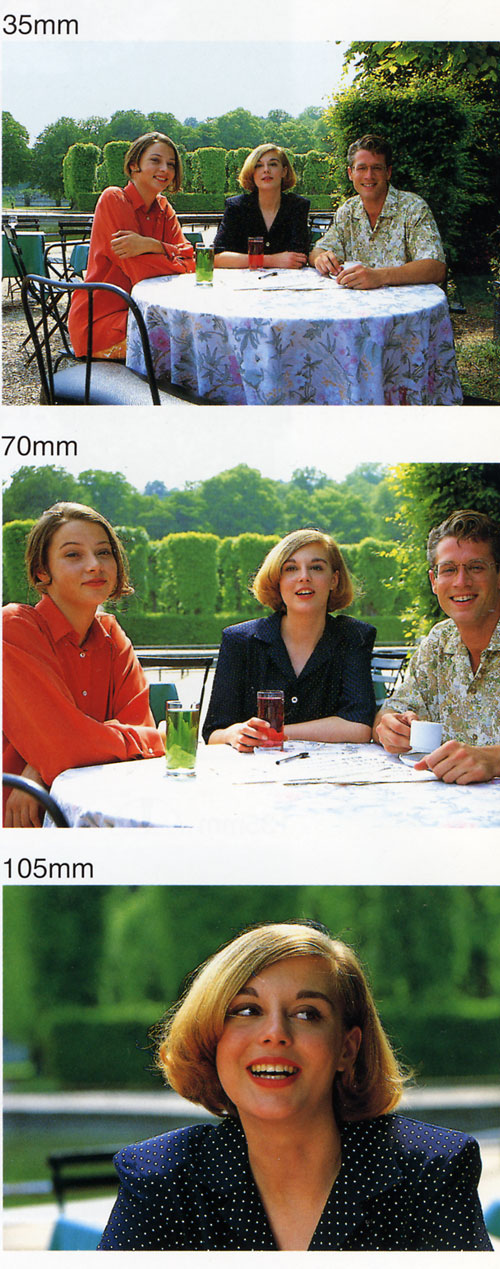
Wide angle, normal and telephoto lenses see different points of view as you can clearly see in this same scene taken with 35mm, 70mm, and 105mm lenses on 35mm film. From the chart above you can see this would be equivalent to 23mm, 47mm, and 70mm lenses designed for 35mm photography and shot on a Nikon or Sony (1.5 factor) digital SLR. This is a very important distinction and critical to understanding how 35mm lenses behave on today's digital SLR cameras. A 28mm lens designed for a 35mm camera "sees" as if it is a normal lens on a digital SLR, a 50mm normal lens "sees" like a 75mm short telephoto (portrait) lens on a digital SLR. Zoom lenses have been around for quite a while now and most will be familiar with the different view captured with each type of lens. However, they may be surprised to find that the 28mm-80mm wide-angle to short telephoto kit lens they bought for 35mm "sees" like a normal to medium telephoto 42mm-120mm lens on the digital SLR. That is why the new kit lenses that sound so exotic like the 18-55mm and 18-70mm are nothing more than the APS C size version of the old reliable 28-80 and 28-105.
Once you get accustomed to the new focal length definitions for digital SLR cameras, things will fall into place. The shorter the focal length the more extreme the wide angle and the larger the "view" included in the image. The larger the focal length value the more "magnified" the image. Wide angle ranges are very useful for interiors and shots of groups of people. Telephotos are great for shooting from an audience or nature photography like birds. Normal of course is a good all-around focal length.
Because existing 35mm lenses make up the bulk of available lenses on digital SLR cameras, and because the real lens value is a multiple of 1.5 or 1.6, it is easy to see that wide-angle lenses are hard to find on digital SLRs. The 35 wideangle 28mm is a normal lens on a digital SLR, and the super-wides usually stop at specialty fisheye lenses around 15mm, which is still a normal wide 23 to 24mm on digital SLR cameras. As a result, almost any extreme wide-angle lenses you will find for digital SLR cameras will be designed just for digital cameras. These include the Sigma and Tamron lenses in the 10-20mm range, and lenses from the major lens makers like the Nikon 11-18mm.

The Olympus four thirds system lens factor is included mostly for reference, since Olympus manufactures a whole new lens line for their digital SLR. None of the older Olympus lenses from 35mm work on the new digital cameras unless you use a special converter. Even with the converter they will work in full manual mode only. The 2.0 lens factor does come into play for third-party lenses designed to work on the Olympus 4/3 cameras, so you can determine the effective focal lengths with the 2.0 multiplier. However, independent lens makers are mainly designing for a 1.5 to 1.6 lens factor, and the 4/3 equivalents are not always very attractive. Sigma markets basic and specialized fast digital lenses in the 18-55mm range. That's a desirable 27/29 to 83/88 on a 1.5 or 1.6 camera. However, on Olympus 4/3 that is a 36-100mm lens. That is still useful, but there is almost no wide-angle when mounted on a 4/3 camera. This is the problem Olympus faces. Until others adopt this open standard four thirds mount, the only lenses designed specifically for the 4/3 system will come from Olympus.
It should now be clear why the digital SLR, with the ability to see through the taking lens, is a more flexible platform for digital photography. Today's Digital SLRs focus and meter exposure through that same taking lens. With auto-exposure and autofocus, a digital SLR can be as simple as any point-and-shoot camera. Plus there is the added flexibility of a much larger selection of interchangeable lenses that are available to allow the user the best chance to capture what they want in any situation. However, despite the fact you don't need to know anything about F-stops, shutter speed, and the light sensitivity of the sensor, we will tell you with absolute certainty that you will take better images if you do understand a bit about what is going on behind those automatic functions.
Photo Basics: Painting with Light
It is very important to understand that whether using digital still photography, digital movies, film stills, or film movies the principals of capturing images is the same. In every case you are capturing images of light on some photosensitive medium. While many people want nothing more than the automatic point-and-shoot available on every digital camera these days, understanding what is happening behind the scenes can help you in selecting the right tools for what you want to do - even if you never plan to use those features.
ISO Speed: The Sensitivity of the Digital Sensor
With 35mm film cameras, an important decision before shooting any photos was what film to buy. Films varied not just in types (slide and print) but most importantly in speed - the ability of the film to respond to light. Film varied from some super-fine-grained ASA 25 to some faster, but grainer, ASA400. Late in film development the most commonly used films were ASA50 to 100 for quality shots when you had plenty of light, and ASA400 to 800 where light was low and you could live with the increased "graininess" of the images.
Several competing film speed systems existed - the US ASA, European DIN, and the Soviet GOST to name a few. All of these systems for measuring film speed were eventually replaced by the ISO system, which basically combined the ASA and DIN systems.
Digital photography has completely changed our ideas of film speed, since the sensor is built into the camera. We no longer have to worry about film speeds or changing film, but digital sensors still use ISO speed to measure their sensitivity. The great thing about digital sensors compared to film, though, is that digital sensors in SLR cameras have a wide range of sensitivity speeds, and you can just choose how sensitive you want the sensor to be. It helps in choosing ISO if you understand what it means.
ISO, or the International Organization for Standardization, eventually developed a standard which combined both the ASA (linear) and DIN (logarithmic) scales into one ISO standard, officially ASO5800:1987. The most common ISO film speed ratings are:
25/15°, 50/18°, 100/21°, 200/24°, 400/27°, 800/30°, 1600/33°, and 3200/36°
The important point to understanding ISO is that a doubling of film speed means the film (or sensor) is twice as sensitive to light. On the logarithmic scale a change of 3° is a doubling of sensitivity. So each number above represents twice the sensitivity of the previous number.
What this means is that at the same shutter speed and aperture (lens setting) you can take pictures in 1/8 the light by using ISO 800 instead of ISO 100. Early digital cameras and digital point-and-shoots often only support a few ISO sensitivities (50, 100, 200) and they rarely support sensitivities above ISO 400. The Digital SLR, on the other hand, normally supports ISO speeds to 1600 or even 3200 on some cameras. This gives the user great flexibility in low light.
There is a trade off, however. As speed increases some digital SLRs do a much poorer job of resolving details in the picture. All Digital SLR cameras seem to do fine from 100 to 400, most go to ISO 800 easily, and some do to ISO 1600 with minimal loss of image detail. In reviewing a camera look at the effects of ISO speed on image quality.
Every digital SLR allows the user to adjust ISO speed, but some make it easier than others. The new Sony A100, for example, has an "Auto" ISO setting that automatically adjusts ISO between 100 and 800 depending on the light in the scene. The new Nikon D80 allows the user to customize the Auto ISO range depending on what they are comfortable with.
In the end, you can adjust ISO, the lens aperture (f-stop), or shutter speed to control the amount of light that strikes the sensor. Any of the three can control the light, and they all have different effects and different limitations. The Auto programs in all digital SLR cameras make these decisions for you, but it is good to know what they are doing in the background, or how to manually make these decisions yourself. One of the great advantages for digital users is that the sensor can operate at many speeds, not just one, and the rest of the "film" is a flash memory that you can reuse over and over. Nothing is consumed in the digital photo process until you want hard images (prints).
F Stop: The Speed of the Lens
Most buyers today are used to the idea of zoom lenses, and they aren't even aware of how many compromises the common "kit" zoom lens forces on them. The biggest compromise by far is lens speed. Film SLR cameras normally came with a normal lens that was rated at an f-stop of f1.7-1.8, where most zoom lenses are rated at speeds like f3.5-f5.6. What is F-Stop, anyway?
F-stop is the focal length divided by the diameter of the lens. For example, a 200mm f/4 lens will be 50mm wide. 200mm/50mm = f/4. That is why f-stop is typically written as F/4, meaning "focal-length over 4" or "focal-length divided by four".

The aperture scale is like the ISO film speed scale in reverse. Each full F-Stop is half the light of the earlier number, and the LOWER the number the more light the lens can pass. Lenses are marked with a range of f-stops. The maximum light-gathering ability of a lens is determined by the lowest number or f-stop, and the rest of the range is adjustments to reduce amount of light the lens will pass. Look at the f-stop scale:
1 - 1.4 - 2 - 2.8 - 4 - 5.6 - 8 - 11 - 16 - 22 - 32
The progression of f-stops are powers of the square root of 2. This means each number, as it increases in full f-stops, will pass half the light of the previous smaller number.
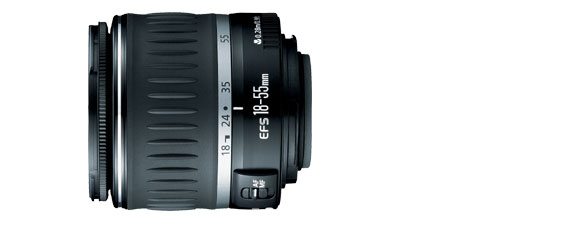
Let's return to yesterday's typical normal lens at f1.7 and today's standard zoom at f3.5-f5.6. F1.7 to 1.8 is a half f-stop, which is 1.5 times faster than f2.0, and f3.5 is a half f-stop between 2.8 and 4.0. So, under the best circumstances, the f1.7 lens is capable of passing FOUR times the light of the zoom lens. This is under the best circumstances, however, since the f5.6 is the other end of a variable aperture. At the f5.6 end, the f1.7 can pass TWELVE times the amount of light of the f1.7. So if we have a zoom lens that is rated 18-55mm f3.5-5.6, it is capable of passing ¼ the light of the f1.7 at the 18mm side, and 1/12 the amount of light of the f1.7 at the 55mm end of the zoom range. In between the amount varies smoothly from 1/4 to 1/12.
Buyers who wonder why they have trouble taking sharp indoor photos with a standard zoom now have their answer. You will have to crank up the ISO, turn on anti-shake if it's an option, or use a flash to supplement light if you plan to take the typical family indoor photos with a standard zoom lens. Or you could buy a normal lens while there are still some on the market and attach a lens that was designed to shoot images in available light.
Depth of Field
Fast lenses are great, in that they allow you to shoot in lower light than a slower lens. However, there is a price to pay for this low-light capability. All things being equal the faster the lens the shallower the depth of field. What do we mean by depth of field?
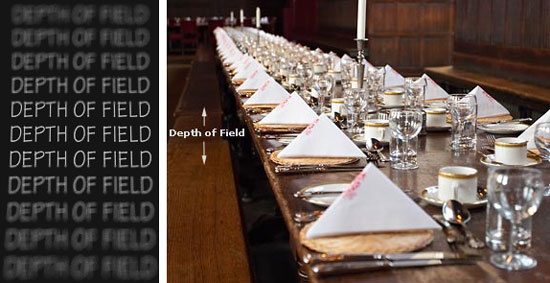
Depth of field is the amount of distance between the nearest and farthest objects that appear in acceptably sharp focus in a photograph. A "good" depth-of field is pretty subjective, since a shallow depth of field might be preferred in a portrait of your girlfriend, but a wide depth of field is preferred in landscape shots. A few factors affect depth of field; they are:
1) the diaphragm opening of the lens (the aperture or f-stop),
2) the focal length of the lens in use, and
3) image size (which has a direct relationship to distance from the subject).
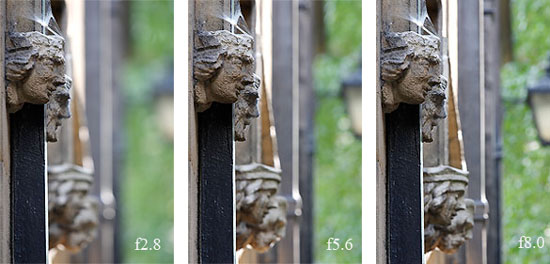
The general rule of thumb is the bigger the lens opening (aperture) used (the smaller the f-stop) the more shallow the depth of field.
This means that critical focusing will be required with a large f-stop because when you use a large aperture - in particular when attempting to focus at a nearby subject - the zone of sharpness (DOF) can be very limiting. On the other hand, if extended depth of field is desired, you can just choose a smaller lens opening (larger f-stop like f/8, f/11, f/16, f/22) to extend the plane of sharpness, so everything will be in sharper focus.
Depth of field also increases with distance. This means the farther you place the camera from your subject, the greater the depth of field. Landscapes have great depth of field, while macro (close-up) photographs tend to have very little depth of field because the subject is so close to the lens.
Shutter Speed: Stopping Motion and Controlling Light
Shutter speed is technically how long the the shutter remains open in a digital SLR or any camera. This is only theoretically the case in SLRs since a focal plane shutter uses a moving slit to expose, but it is close enough for our discussion about photo basics. There is an old rule that any photographer, even an amateur who doesn't care about understanding the process, needs to commit to memory. We will make it bold.
The fastest shutter speed you can hand hold is 1 over the focal length of the lens.
What this means is the fastest blur free picture you can shoot is at a shutter speed of one over the effective focal length of the lens. This means our 18-55mm lens, which acts like a 28-85mm lens can produce sharp pictures at 1/30 second or faster at the wide-angle end and 1/125 second and faster at the telephoto end. Some people are really good at holding a camera steady and can do better than this, but this is always a good rule of thumb.

The shutter speeds for a digital SLR are much wider than you will find on a point-and-shoot digital. Where the point-and-shoot might do 2 or 3 speeds up to 1/600s, the digital SLR offers a very wide range of shutter speeds. Most SLRs today perform over a range of about 30 seconds to 1/4000 second, and the shutter speed range is similar to ISO in that the larger the number the more light is passed. The scale is also approximately linear:
1 - 1/2 - 1/4 - 1/8 - 1/15 - 1/30 - 1/60 - 1/125 - 1/250 - 1/500 - 1/1000 - 1/2000 - 1/4000
Each value going faster passes half the light of the lower value. So 1/15s passes twice the light of 1/30s. This brings us back to the other part of why you get blurry pictures with your kit zoom lens indoors. Since the kit zoom passes 1/4 to 1/12 the light of a normal f1.7 lens, it must shoot at slower speeds (let in more light) for proper exposure. When you fall below 1/60 to 1/30s those properly exposed images will be blurry with your kit zoom.
Taking a Picture: Putting it All Together
Now that the basics of how a digital SLR works have been covered, we are ready to put it all together. For those who have had enough of new ideas to remember and balance it should be pointed out that you don't really have to understand or adjust any of this to take images with a digital point-and-shoot or a digital SLR. All the digital SLR cameras on the market are autofocus and auto-exposure, and some even have the very consumer-oriented programs that make decisions for you in tough situations like backlight or sports. However, without understanding a bit about what your automatic camera is doing you will never figure out why that kit zoom takes blurry shots of your family on Christmas morning or your son's birthday party or your daughter's dance recital. With understanding you can make choices to fix these problems.
Why the Kit Lens is a Dog
For some reason, the world has moved to zoom lenses. There is no doubt they are definitely convenient for cropping in the camera, but most people would rather have a sharp picture they can cut in Photoshop instead of a blurred one that is already cropped. You see, people seem to have forgotten the compromises of most zoom lenses. To better understand this let's look at equivalent exposures.
| Shutter Speed to f/stop Comparison | |||||||||||
| Shutter Speed | 1/4 second | 1/8 | 1/15 | 1/30 | 1/60 | 1/125 | 1/250 | 1/500 | 1/1000 | 1/2000 | 1/4000 |
| f/stop | f/45 | f/32 | f/22 | f/16 | f/11 | f/8 | f/5.6 | f/4 | f/2.8 | f/2 | f/1.4 |
If you followed our discussion of the basics, all of the exposures above represent the same amount of total light. As shutter speed increases (less light) then aperture decreases (more light). The chart below also shows equivalent exposures - we have just shifted the values to a common indoor scene at a moderately "fast" ISO of 400.
| Shutter Speed to f/stop Comparison | ||||||||||||
| Shutter Speed | 1/2 second | 1/4 | 1/8 | 1/15 | 1/30 | 1/60 | 1/125 | 1/250 | 1/500 | 1/1000 | 1/2000 | 1/4000 |
| f/stop | f/16 | f/11 | f/8 | f/5.6 | f/4 | f/2.8 | f/2 | f/1.4 | - | - | - | - |
As you can clearly see our old normal f1.7 can shoot this between 1/125 and 1/250 - which is plenty fast enough to get a sharp picture with equivalent 75mm f1.7 normal on a digital SLR. A 28mm f2.8 would behave like a 42mm f2.8 normal lens and also be fast enough to shoot at 1/60s. Our kit 18-55mm is equivalent to a 28 to85mm,. At the short end at 1/45 s it is probably fast enough to capture a sharp image, but it gives out quickly and will definitely yield blurred images at anything above about 45mm. At the telephoto end of 85mm (55mm) the shutter speed for the fastest f5.6 is 1/15s - which will definitely be a blurry picture. If you were shooting at ISO200 nothing would be sharp with your kit zoom under these conditions, as everything would shift a notch to the left. At the default ISO 100 the best you could do would be between 1/8 and 1/15s and blurry.
The point is, your kit zoom is for shooting outside and indoors with flash at limited range. It is the wrong tool for available light photography. If you have followed this it is our advise that you buy a normal lens as your first interchangeable lens for your digital SLR. Canon and Nikon still make reasonable 50mm f/1.8 lenses, which also happen to be the sharpest lens in either lens lineup. The bonus on a digital is it becomes a 75mm f1.8 fast short telephoto, which is great for portraits and available light photography. Bonus two is that the close focus is the same but the image is magnified by a 1.5 to 1.6x factor, making the lens a terrific macro lens. Minolta has a great 50mm f1.7, as does Pentax, but used prices have been rising recently. The other option is a 28mm or 35mm lens. There are plenty available at f1.8 to f2.8 on the used market and you get a fast true normal lens of 42mm to 53mm focal length. Since the APS C or DX format only uses the center of the image, the third bonus is that even mediocre lenses with edge falloff in the corners on 35mm are normally very sharp in the area used in digital SLR photography.
There is also a new market developing for fast fixed focal length lenses for the APS C/DX. Several companies have announced new 30mm to 50mm f1.4 to f2.0 lenses for the smaller APS C/DX format. Sony picked up the Minolta 50mm f1.4 for their new lens line, though we wish they had also picked up the excellent and reasonable 50mm f1.7 instead of just the $350 f1.4.
There is also the option of fast zoom lenses, but zoom lenses are rarely if ever as sharp as fixed focus and the prices for fast zooms are high. There are several independent and brand name zooms in the 28-75mm f2.8 format. They range in price from $450 to $5000 or so. Fast, quality zoom lenses cost big money, because they are hard to design and expensive to make. A fixed focus lens gives you that pro quality at a much lower price - particularly if that fast fixed lens is a normal 35mm lens.
Image Stabilization
Image stabilization was first introduced by Nikon and Canon in specialized lenses designed for action photography. These lenses were first designed for pros at pro prices, but they quickly found their way to consumer zoom lenses with wider zoom ranges than kit zooms. The advantage of the image stabilization is that the stabilized zoom lens can produce sharp images at a couple of f-stops slower than the normal rule. That means a 125mm focal length can be handheld with sharp results down to about 1/30s, while a 28mm wide angle can go down to 1/8s or less. The problem with these "image-stabilized" lenses is that they are relatively expensive, starting at $300 or so and going up to thousands of dollars.
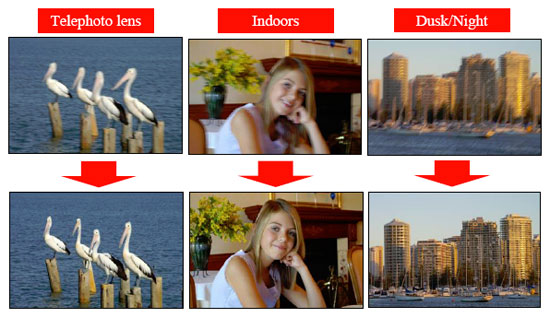
More recently, Minolta introduced image stabilization into the SLR camera body. That means any lens mounted on the camera can have the advantage of image stabilization. The Minolta Maxxum 7D was the first interchangeable lens SLR to offer this feature, which was also continued on the mainstream-priced 5D. Sony has continued this feature in their new 10.2 megapixel $899 A100 and improved the effectiveness, they say, to 3 to 3.5 stops. Sony has also licensed the steady shot technology to Pentax, which uses it in their K100D and the announced K10D. It will also appear in future Samsung SLR cameras, since they use the Pentax mount and are basically relabeled Pentax cameras.
Image stabilization, with custom lenses or built into the camera body, allows normal zoom lenses to act like they are faster - some 2 to 3.5 stops faster - and this makes them usable in the difficult situations we described above for zoom lenses. It is a good feature, but keep in mind that the body-integral steady shot also works with any lens, including the fast normal lens. This extends the useful speed of the normal lens even further, just as it does the zoom lens.
One significant advantage of image stabilization with a normal lens is the ability to shoot greater depth of field in available light. Shots that were doable before with shallow depth-of-field, can now be shot with a greater range or depth of sharpness. This is particularly useful for things like we do at AnandTech - shooting motherboards in available light to avoid hot spots, while still keeping the entire board in sharp focus.
Digital Challenges: What Needs to be Improved
Despite the huge leaps in digital technology in the past few years, there are still a few issues remaining. Most of the sensor makers and camera/lens manufacturers are working on these issues. You should keep them in mind when looking at digital SLRs, because they are the areas where development is needed.
Dynamic Range
Compared to film SLRs, digital SLRs still cannot match the dynamic range of film. Dynamic range is the difference between the brightest highlights and darkest shadow detail in an image. Most manufacturers are working very hard to provide improved dynamic range, but there is no consensus yet on what works or will work best to fix this problem. Solutions vary from the extra set of pixels designed just to capture highlight detail in the Fuji S3 PRO (for Nikon lenses), to the Bionz image processor in the new Sony A100 electronics, and the D-Lighting feature in the new Nikon D80 that can be used to improve shadow or highlight detail.
Most users are not really aware of this issue, and sensor and camera makers are not making a big deal about it unless they have a feature that improves this weakness. However, if you examine a high contrast image from film next to the digital image you will see highlights blowing out on the digital image and less shadow detail in the digital image. Digital has improved greatly in this area, and will no doubt continue to improve, but the dynamic range difference is still about 1.5 to 3 stops better with film than digital.
In shopping for a digital SLR you might pay attention to those that claim to address this issues and what they have done.
Dirt on the Sensor
One of the early problems identified by users of digital SLRs with interchangeable lenses was that the sensor could easily get dirty in the process of changing lenses. Unlike film cameras, where this issue went away with a film change, a dirty sensor will make all future photographs spotted with specks. This issue is particularly troublesome in digital cameras, because the sensor coatings are very delicate and the SLR needs to be returned to the manufacturer for cleaning dust from the sensor.

Most manufacturers have software tools to minimize this problem, mathematically "removing the spot and filling in with calculated pixels", but the first manufacturer to address it on the prevention end was Olympus with their wave filter. They provided a protective coating on the sensor and also used ultrasonic vibrations to clean the sensor on start-up to remove any dust that may have gotten through.
Sony also introduced a protective coating and start-up vibration feature to protect from and remove dust on their new 10.2 megapixel A100. Pentax and Samsung have apparently licensed the Sony system, as they have announced similar mechanisms on their new 10.2 Sony-sensor cameras. Even Canon, who denied for quite a while that there was a dust problem, is now providing the "EOS Integrated Cleaning System" on their new 10 megapixel Rebel XTi. The XTi uses special antistatic sensor coatings and an ultrasonic cleaner much like Olympus.
Auto White Balance
White Balance was not really discussed in this introductory guide, but digital cameras, unlike film, allow the user to set the color temperature or color balance of the sensor. With film you had to choose daylight (or flash), tungsten, Fluorescent, and other color balances when you selected film. In digital imaging you select the "color temperature" when you shoot. You can also leave the color temperature on Auto and let the camera choose - or be really fancy and measure color temperature (most SLRs have this capability) and set a Custom temperature.
Most users leave it on Auto, but we have yet to see a digital SLR that does a decent job with common indoor lamps and lights (tungsten) on the Auto setting. Almost all Auto settings seem to leave an orange cast in the images shot under indoor light. This can normally be corrected in images shot in RAW and some images shot as JPEG, but the easiest solution by far would be an Auto setting that really works. The best solution today is to move off the Auto White Balance setting to Tungsten (Indoor Light) when shooting indoors. Today's cameras do generally apply the correct temperature when the tungsten white balance is selected. Until this is fixed in the majority of Digital SLR cameras we plan to test the Auto setting under indoor lighting in our reviews.
Lens Confusion
This guide should help with confusion about lenses and lens factors, but the problem won't go away until camera and lens makers decide on a standard. Right now digital SLRs are still basically fed with 35mm lenses, even though the sensors are APS C and DX size and have a smaller image circle. It appeared for a while that the industry would settle on this APS C/DX size and eventually name lenses by their equivalent APS C/DX focal lengths once 35mm faded away. Now the outcome is less clear. Some now predict the SLR market will move to two tiers, with APS C/DX SLR cameras as mainstream and full-frame 35mm-size sensors at the Pro end. This certainly would maximize the existing 35mm lens line of the big camera manufacturers and still provide an upgrade path for advanced amateurs. This is the path that Canon appears to be following, but Nikon is still committed to the pro APS C/DX sensor size.
If you look closely at the new lenses Sony introduced you will see even more confusion. Sony does not make 35mm film SLR cameras, so there is no reason for them to introduce new lenses designed for 35mm just for the current Minolta film owners. Yet 2 of the 3 new Sony Carl Zeiss lenses are designed for a 35mm image circle. This leads observers to believe that Sony, one of the largest sensor manufacturers in the world, may be hedging their bets on a full-size 35mm sensor Sony SLR. It is also interesting that the major camera makers that have extensive lens lines seem to have slowed their introduction of lenses designed for APS C/DX sensor size. There is no crystal ball, but it will be interesting to see where the digital SLR industry goes in the near future.
The lens confusion and format confusion is likely to continue for a while, since none of the manufacturers except Olympus, with their all-new digital 4/3 system, have truly committed to a new sensor size. If Sony or Nikon introduce a new Pro full-size 35mm sensor in the near future, you can expect the industry to segment as Canon has now done with their 35mm sensor Pro EOS 1D Mark II and EOS 5D versus the rest of the Canon line whish uses an APS C sensor with a 1.6 lens factor.
Gaps in the Lens Lines
Perhaps because of the lens confusion, there are still gaping holes in the lens lines of the APS C/DX format digital SLR cameras. Due to the 1.5/1.6 lens factors the 35mm wide angles are pretty useless on a digital SLR. There is still a need for additional wide angle lenses that are wide angle on APS C/DX. The Sigma 10-20mm and Tamron 11-18mm help, but pickings form the majors are very slim. So are DT size lenses from the majors that address the need for fast fixed-focal-length wide-angles and fast normal lenses. Pentax recently introduced 21mm f3.2 and 40mm f2.8 pancake (flat) lenses for their digital line. Samsung recently announced they would introduce a 35mm F2.0 lens for their digital cameras. These three lenses will bring new options to digital photographers shooting with the Pentax KA mount.
Moving Forward: Digital Camera Reviews at AnandTech
Digital SLR cameras have come a very long way in a very short period of time. They have gone from very expensive instruments affordable only to corporations and professionals to the fastest growing segment of the imaging market in only a few short years. Many of the early problems like low resolution, slow startup, slow saves of images, high energy requirements, and bulky batteries have all but disappeared. The fairest measure of the state of Digital SLR cameras is that today they are not much different in appearance and function than the last generation of film cameras. In general, however, they offer even more electronic sophistication than the film cameras they replace.
Recent digital SLR cameras are capable of 1000, 2000 or even more images on a single battery charge. Digital SLRs are also getting smaller in general, and now average even smaller than the last generation of film SLRs. Despite the decreasing size, many camera makers are paying much more attention to ergonomics - how the cameras feel in the users hands - and the smaller digital SLRs handle very well.
For all of these reasons you will find many more digital SLRs than point-and-shoot cameras in future digital camera reviews at AnandTech. This is because the digital SLR is now the fastest growing segment of the digital camera market, and that is where most of the new camera introductions will happen. This does not mean we will ignore the digital point-and-shoot, as there is always a place for a small, pocketable, and reasonable digital camera. It does mean AT will pick more carefully among the point-and-shoot cameras we will choose to review.

The Sony Alpha or A100 and Nikon D80 are already planned for review. They are the first of the new breed of affordable (under $1000) 10 megapixel SLR cameras. We will also review the other announced members of the 10 megapixel club - namely the Canon Rebel XT1, Pentax K10D, and Samsung GX-10 - when they become available in the market. As stated at the beginning of this guide, we really need your help in deciding how to test these cameras.
Many of the tests used at photo websites have very little real relevance to the digital SLRs of today. Start-up and shot-to-shot times are all but instantaneous with the latest models and even those fast times continue to improve. Virtually none of the lags of early digital cameras remain, and the response time no longer reminds you that you are using a digital SLR camera. Since SLRs have interchangeable lenses there is no fixed lens to review and every major lens line has some incredible lenses and a few dogs. Do you want us to test the standard kit lens in our upcoming reviews or should we use a standard quality lens for all tests in that line like a 50mm f1.4? Or both?
What tests would you like to see in the digital camera reviews? This is your time to sound off. Resolution targets are available and it is fairly easy to determine resolving ability of the kit or a standardized lens. Would these be useful to you in our reviews? There has also been the suggestion that we shoot a standard scene (the same scene) in every review so readers can compare fine details like color balance and resolution. If you want that let us know. We are open to new ideas and new ways of examining digital cameras in AnandTech reviews. We have a different audience than the photo websites and we want our reviews to provide you with what you are looking for.
We sincerely hope you enjoyed our overview of digital photography, with a slant toward the digital SLR. It is our belief that, in contrast to computers, many readers at AnandTech don't know a lot about photography and digital cameras. Some of you are very knowledgeable, but our letters indicate many more readers have been shopping for digital cameras with little understanding of how they work or what to look for. The purpose of this Guide from 20,000 feet is to provide a broad overview with enough specifics to help our readers become better shoppers for digital cameras in general and digital SLRs specifically. If we helped in that arena please let us know in your comments. If there are additional articles on digital imaging you would like to see in the future we would be happy to hear your suggestions.







